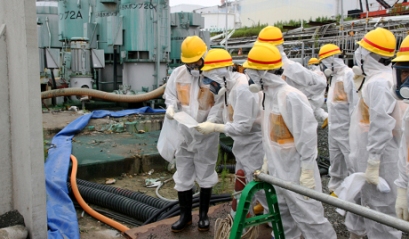2013-12-26

Fukushima is worse than Chernobyl: radiation affects fish, World Ocean, West Coast - experts
フクシマの影響 米国にまで チェルノブイリより酷い福島
Boris Pavlischev
ボリス パヴリシェフ
25 December 2013, 14:40
Three years on, the general public is still nervous about the Fukushima Daiichi nuclear power plant disaster of March 2011. Heavy rain has caused more contaminated water leaks over the protection dike recently. The Japanese are increasingly distrustful of atomic scientists' claims that the contaminated water has failed to make it to the ocean. Meanwhile, The Cape Cod Times US newspapers reports that the Fukushima toxic waste is reaching the US West Coast, while 70 crewmembers of the US Ronald Reagan aircraft-carrier, involved in the relief operation in the wake of the disaster, are filing a lawsuit against the TEPCO Fukushima operator company, claiming the Japanese company had failed to warn them of all the risks that they were running during the operation.
福島第一原子力発電所は事故から3年近く経った今でも社会を騒がせ続けている。最近、強い雨の影響により再び汚染水が漏れ出す事件が発生した。専門家らは海にはもれていないとしているが、それを信じる人はますます少なくなっている。米紙「The Cape Cod Times」は、福島原発から放出された有害物質が米国西海岸に近づいていると報じている。また事故後の救助作業に参加した米海軍空母「ドナルド・レーガン」の乗組員70名は、東京電力が十分なリスク説明を行っていなかったとして訴訟を起こしている。
Navy Sailor Claims TEPCO Mishandled Nuclear Disaster: Fifty-one crew members of the USS Ronald Reagan say they are suffering from a variety of cancers as a direct result of their involvement in Operation Tomodachi, a U.S. rescue mission in Fukushima after the nuclear disaster in March 2011.
USS Ronald Reagan was riding athwart in the radioactive discharge plume 10 miles away from the crippled Fukushima plant. The crew desalinated seawater to use it in cooking, with some crew members developing cancerous diseases and/or becoming blind as a result.
ロナルドレーガン号は機能を失った福島原発から10マイル(16km)離れたところで排出された放射性プルームの中を横切っていた。乗組員は海水を淡水化し料理に使っていた。何人かの乗組員がその結果、癌性の疾患、失明などを発病している。
The contamination of the ocean within the 10-mile zone of the nuclear power plant is due to the fact that some of the reactor nuclear decay products made it to the ocean, rather than to the air, as was the case in Chernobyl in 1986. Currents take harmful agents to great distances, so the seafood and fish that are caught in the contaminated currents even in other parts of the world may still prove a health hazard, says the Deputy Chairman of the State Duma Committee on Natural Resources, Maxim Shingarkin.
その原発から12km圏内の海の汚染は、原子炉から放出された物質の主要部分が1986年のチェルノブイリのように大気中に放出されたのではなく、海に放出されたためと見られている。それは海流にのってとてつもない距離を移動し、地球の反対側であっても、海産物が汚染される恐れもある。ロシア議会下院(国家会議)天然資源委員会のマクシム・シンガルキン委員長は次のように指摘している。
"Because of the World Ocean currents, the seafood that's caught off the US Pacific coast is more likely to contain radionuclides than the seafood in the Sea of Okhotsk, which is by far closer to Japan. It is these marine products that may find their way to the tables of different countries' residents that pose the gravest danger," he said.
「世界の海流を考えれば、米国北西海岸における放射線量は、日本に近いオホーツク海よりも高くなる可能性もあるのです。人類にとって最大の危険となるのは、それらの海域で採られた海産物が大量にいろいろな国で食卓に給されることなのです。」
Contaminated fish may have been caught and delivered anywhere. From now on one should bear in mind that it's impossible to check the entire fish catch for radiation. This is what the co-chairman of the Eco-Protection international environmental group, Vladimir Slivyak, says about the situation in a comment.
汚染された魚は捕獲されどこにでも運ばれる可能性がある。これからはすべての漁獲を検査することは不可能だということを心に留めるべきである、と国際環境保護団体「エコザシータ」の共同委員長であるウラジミール・スリヴャクは現状況についてコメントしている。(それは漁獲を一切禁止することができないのと同じだ。日本政府はそれでも、一部の最も危険な海域における漁獲を制限している。)
"Russia has been considering setting limits on catching marine products and fish in the Far East. But no restrictions have officially been imposed thus far, to the best of my knowledge. But some moves may eventually be made," he said.
「ロシアは極東での海産物、魚の漁を制限しようと考慮してきました。しかし、わたしの知る限り公式な制限は今のところ全く課せられていません。いずれは何らかの動きがあるかもしれません。」と彼は話した。
As regards atmospheric contamination, the crippled Fukushima plant radionuclides are known to have reached California and Mexico eight days after the disaster. Russia was unaffected by the propagation of radiation, says Maxim Shingarkin.
大気中における汚染に関してみれば、事故から8日後にはすでにカリフォルニアおよびメキシコに達している一方で、ロシアには届かなかった。シンガルキン委員長は次のように指摘している。
"The radioactive discharges to the atmosphere had failed to focus on either the Sea of Okhotsk, or Sakhalin Island, or the Far East, or the Kuril Islands. Besides, radiation transfer through the air has so far posed little or no danger. But let's wait and see, for not all fuel has been removed from the damaged nuclear reactors yet. We can therefore expect atmospheric radiation releases as a result of the heating up of reactors," he said.
「大気中における汚染については、オホーツク海やサハリン、極東、クリル諸島には届きませんでした。ですから、大気経由による危険はいまのところありません。「今のところ」というのは、原子炉からまだすべての燃料が取り出されたわけではないからです。つまり、また大気中に有害物質が出てくる恐れがあるのです。」
It took years in the wake of the Chernobyl accident to draw more accurate conclusions about the scale of radioactive contamination. The situation around Fukushima seems to be pretty much the same, says Vladimir Slivyak, and elaborates.
チェルノブイリ事故の後、すべての有害物質についての規模をまとめるためには長い年月がかかった。国際環境保護団体「エコザシータ」のウラジーミル・スリヴャクさんは、福島についても同様に時間がかかるだろうと指摘し、次のように話している。

"We are likely to learn about the detailed consequences of the Fukushima nuclear disaster in a matter of 10 to 15 years. It is clear that a great deal of fisheries, water grass areas and actually anything in the ocean has been contaminated. Fukushima radiation is understandably spreading across the world. It is obvious that large areas have been contaminated in Japan. But it will take years of research to get a more detailed picture of the Fukushima disaster consequences," he said.
「10年から15年経てば、この事故の詳細が分かるでしょう。魚や海草など、海洋にあるすべてのものが汚染されていることは確かです。またそれが全地球に広がっていることも確かです。日本国内において広範な土地が汚染されていることも確かです。つまり、そのような点についてははっきりと分かるのですが、そこからより詳細な情報と福島事故の結果が何であるかとなると、長い時間をかけて調査を行わないといけません。」
Meanwhile, tests in California found that the blue-fin tuna caught in coastal waters were contaminated, according to the globalresearchreport.com portal. The contaminated water has most likely reached the area, since radioactive iodine levels have grown more than 200 times. The level of caesium-137 has also grown along the entire length of the US West Coast, the radioactive caesium was found in local berries and mushrooms. Meanwhile, local residents have reported more frequent bird deaths recently. Radionuclides have made it even to the Alaskan coast, causing a decline in the sockeye populations there. Some experts claim we are yet to see more consequences of the 2011 Fukushima nuclear power plant disaster.
いまでもカリフォルニア沿岸で獲れるマグロはすべて放射線が含まれている、という結果がglobalresearchreport.com で示されている。褐藻類に含まれる放射性ヨードが200倍以上に増えているため、おそらく汚染水が達したものと見られている。米国西海岸でのイチゴおよびキノコにおけるセシウム137も上昇している。すでに鳥が死亡しているとの報告も地元住民から上がっている。放射性物質はアラスカ海岸へも到達し、ベニザケの数が減少することとなった。専門家の中には、2011年の福島原発事故による結果を更に見ることになるだろうと主張している。(ただ、このような資料はいまだに事故による影響の全貌ではない。)
注)日本語訳は英文記事に従って編集しています。
Note: Japanese translation is edited according to the English description.


